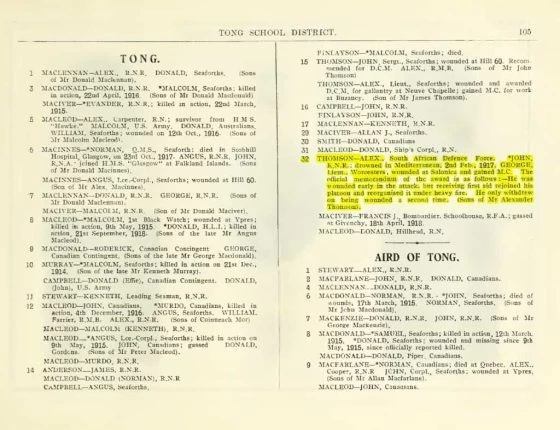Alexander Thomson and Janet Ferguson
Alexander Thomson
Alexander Thomson was born in Tong, Isle of Lewis, Scotland in about 1840. He was the son of Alexander Thomson and Christina MacInnes whose story is told on a separate page. He was the oldest of three generations of Thomsons to live in 32 Aird Tong, the youngest being my father who was born there in 1910.
Janet “Jessie” Ferguson
Janet Ferguson, who was known as “Jessie”, was born on 1 November 1842 in Gress, Isle of Lewis, Scotland. She was the daughter of Evander Ferguson and Ann Murray, whose story is told on another page.
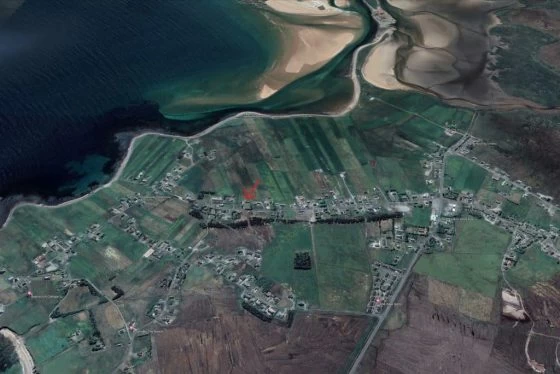
The Isle of Lewis
The Isle of Lewis (more properly the Isle of Lewis and Harris) is the largest island of the outer Hebrides or Western Isles. It is also the most northerly. The southern half of the island is rocky and mountainous while the northern half is flat, soft moorland with many lochs. The island is surrounded by beautiful white sandy beaches. The climate is influenced by two main factors; the Gulf Stream and the prevailing south-west wind. The Gulf Stream is a warm ocean current coming from the south west from the Gulf of Mexico.
The prevailing south west wind is warm but also moist as it passes over the Atlantic. The climate is, therefore, warmer than one would expect at such a northerly latitude but it is also windier and wetter.
Birth of Janet “Jessie” Ferguson
The illustration opposite is a copy of the Parish Register for Gress. It is hard to read, but can be transcribed as
“Evander Ferguson and Ann Murray, his spouse, a daughter born [Illegible] Janet”
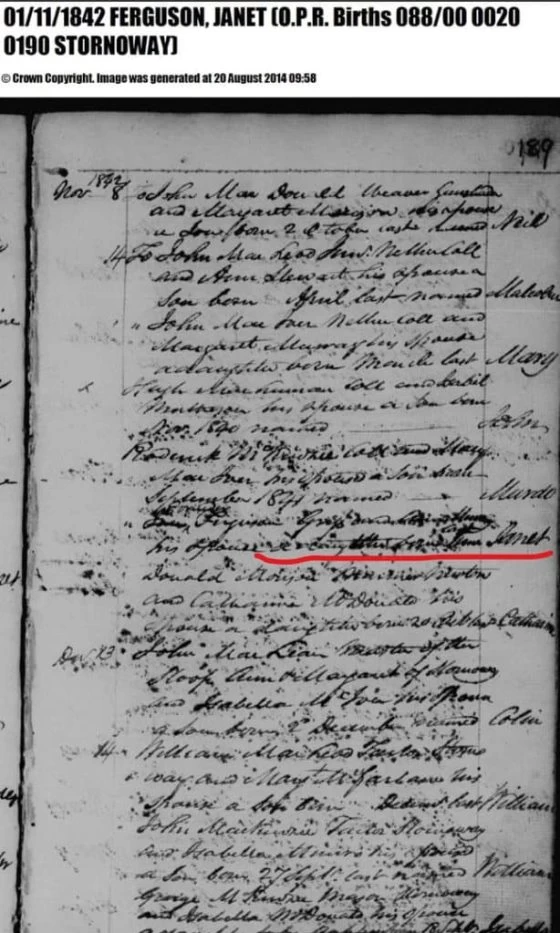

Marriage
The Certificate opposite is the entry from the Marriage Register for Back Church. Alexander records his occupation as a fisherman, whereas his father records his occupation as a crofter. It is interesting that both he and his wife sign the Register with a cross as their mark, so presumably neither could read or write.
Fishing Industry
The fishing industry in Lewis included deep sea and inshore fishing. Deep sea fishing was with nets or long lines. The nets were used by the drifting method for herring in the right season. The long lines were used for cod, ling and other larger fish. For inshore fishing the main work was done in small open boats using oars or sail. The fish, mainly haddock, were caught by small lines. The small boats were at sea for only a few hours at a time whereas the net fishers were at sea from late afternoon until the following morning.
The crew then sold their catch, cleaned up their ship and set sail again. On Saturday the ship was tied up and locked while the crew went home until Monday morning.
Many of the crofters were also fishermen and it is doubtful if the croft alone could support the family without the additional income from fishing and the very considerable amount of food provided by the in-shore fishing.
From early in the eighteenth century until the Second World War the herring fishing industry grew rapidly, reaching its peak around 1930.
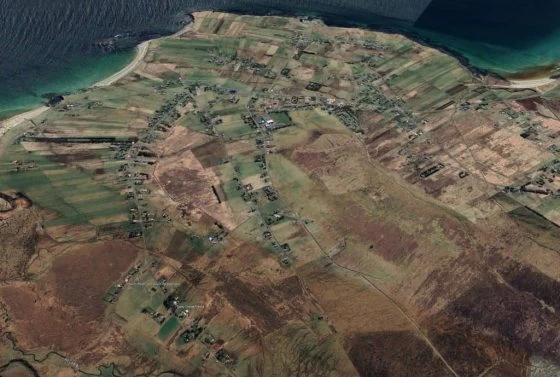
Stornoway Harbour
The town of Stornoway grew up around a small but sheltered harbour. The original castle stood where the main pier stands today but it disappeared many years ago.
In 1633 Oliver Cromwell sent a small force to take and hold Stornoway. They took it without opposition but did not stay long. The inhabitants attacked their headquarters after a few months. Although the invaders won the battle they withdrew from the island soon afterwards. They did, however, leave a few reminders of their stay.
The main street of the town is called Cromwell Street today and the main square is Percival Square. Between Stornoway and Sandwick there is a sharp rise in the road which is still called Oliver’s Brae.
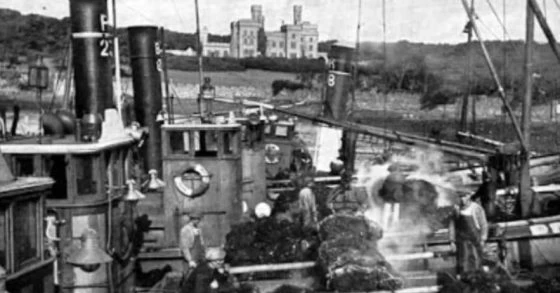

The Fishing Boat called “Nothing”
Alexander Thomson of 32 Aird Tong, was a full time herring fisherman from the port of Stornoway. In 1884 he bought a new, larger fishing boat (24 tons and 52 foot keel) and went to register it at the Custom House. He was so excited about his new acquisition that he had not thought of a name. The clerk had taken all the details of the new boat and asked him what name he had given it. Caught unprepared Alexander said hesitatingly “Nothing”.
Before he could stop the clerk, he had entered the name “Nothing” in the register. My great grandfather decided that it was God’s will and left the name to stand. Unfortunately he had forgotten how very superstitious all seafarers are. No self respecting fisherman would dream of trying to earn a livelihood in a ship called the “Nothing”.
After much pressure and persuasion he got enough men together to crew the boat with himself as skipper. When the season ended that year the “Nothing” stood high among the top earners. There was no more difficulty in finding a crew.
Herring Fishing
The herring fishing began in Barra and Mallaig on 10th April and in Stornoway on 10th May. It moved to Wick and Lerwick on 10th June and along the Moray coast on 10th Ju!y and so the fleet moved down the East coast of Scotland and England reaching Lowestoft and Yarmouth in October and November.
My father recalls in his notes that:
“it was on a return visit home from East Anglia that my grandfather, on one occasion, picked up a large windmill and brought it home to Tong. The sails of the windmill were so large that the machinery had to be housed one floor up above ground level. For this reason 32 Aird Tong had a two storey extension added to the west end of the house. That extension is still present today (c1990).
The last time I visited the old home the extension was occupied by a tweed weaver’s loom. It was very noisy but not nearly as noisy as the old windmill had been. Looking back and recalling the noise of the old windmill I often wonder if my grandfather had ever heard of lubricants!”
Sadly, I don’t have a photograph of the windmill, but I would love to see one if anybody has ever seen one.
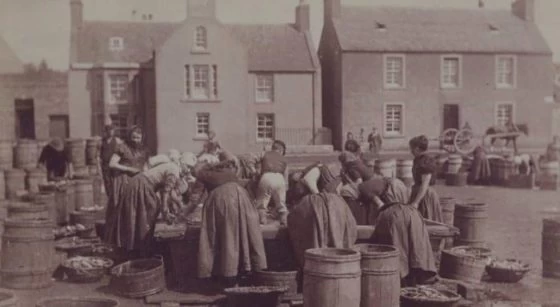
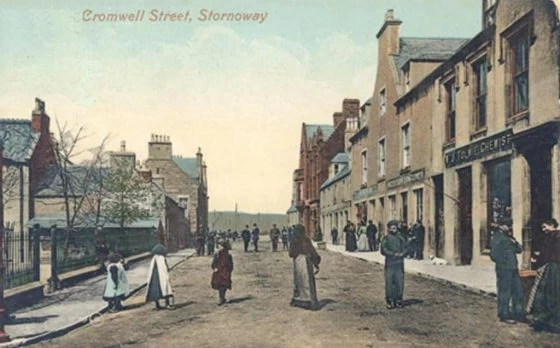
Elder of the Kirk
The following is an extract from my father’s history. “Alexander Thomson, my grandfather, was also an elder of the Kirk. The village of Tong had no kirk originally but the villagers together built a Meeting House in which the elders, including Alexander, usually took the service.
The nearest clergyman, from Back, occasionally came to take a full service. The services were, of course, in Gaelic. When Alexander took the service he had to lead the singing and this was a serious problem as he had no musical sense whatsoever. The metric psalms were sung by the method known as “presenting” where the leader sang each line followed by the congregation. I have often been told that when my grandfather “presented” the congregation always sang to the tune of St. David – not because his “presenting” was ever recognisable as such but because they all knew it was the only tune he ever attempted.
Some time after he died when I was a pupil in the junior school in Stornoway I decided I would like to join the Junior Choir. The test was brief and decisive. I was refused. The teacher had known my grandfather and his singing ability and commented that I was not as good a singer as my grandfather had been! It took me a few years to realise the great wisdom of her decision.
War Service
The illustration opposite is an extract from the Lewis Roll of Honour. I have highlighted the entry for 32 Aird Tong. Alexander Thomson had served in the South African Defence Force during the Boer War, and also served in the First World War.
Also listed is my grandfather John Thomson, who was lost at sea in the Mediterranean on 22 February 1917, and also my father’s Uncle George who is pictured above.
Uncle George as he was known to me, even though he was a great uncle, lived just round the corner from my grandparents in Glasgow. So we were regular visitors, when we visited my grandparents.
